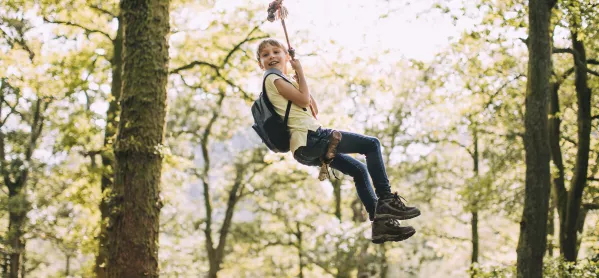Despite my determination to keep my eyes fixed on the horizon, I caved and made the rookie mistake of glancing down. I saw the ground some 10 metres beneath my dangling legs. I immediately began to regret the life choices that had brought me to this point.
Heart hammering, I returned my gaze to the horizon, looked over the tree tops to the hills beyond and locked my eyes on a tractor and some tiny sheep, far in the distance. The 10-year-old girl next to me began to cry softly as we were hoisted higher and higher. Once again, I asked myself what the hell I was doing way up here, dangling from a metal bar in the middle of a Scottish forest.
For the uninitiated, the innocuously named “Giant Swing” is a steel beam to which your safety harness is connected before your teammates begin the long and laborious process of hoisting you up into the tree canopy until you are nearly horizontal, staring down at the ground so very, very far below.
Background: Decision not to fund outdoor centres is ‘catastrophic’
Outdoor education: Outdoor play officially ‘fundamental’ to learning
Coronavirus: ‘It’s time for all schools to head outdoors’
That experience is stomach-churning enough, but the real challenge has only just begun. Because there’s only one way to get down once you are up there - pull the release cord and let the swing do its thing.
The thrill of outdoor education
The girl beside me was crying in earnest now and I felt like joining her. I edged closer to her and tried to keep the tremor out of my voice, as I said: “It’s OK, we don’t have to do this.” She paused, took a deep breath and slowly turned her head to look straight at me. “Yes, we do,” she said. And, without another word, she pulled the cord.
We dropped. My heart stopped. We fell for what felt like forever then, with a bone-grinding lurch, we flew. Our feet were above our heads, the sky and the ground seemed to swap places. We soared through the trees, and screamed with the pure joy of being alive.
After an age the swing came to a gradual stop and the other children rushed over to us, whooping and calling and thumping us on the back, crying: “You did it! You did it!”
I looked at the tiny 10-year-old girl next to me. I had coaxed her over many months into coming on the school residential. She had never been away from home overnight, never ridden a bike or climbed a tree. She did not take chances, did not think she had any courage at all. “You did it,” I whispered to her. She turned to me and I saw that steely determination was still there, stoking a new kind of fire where previously there was none. “Yeah,” she said with a small smile, “I did.”
Governments of the UK, here’s my message to you: do whatever you must to save our outdoor education centres. Do it for the campfires and the bedtime stories and the mud. For the sleep deprivation and the swinging through the forest and the boundless energy of the people who work there. Do it for the children who don’t believe they can and for those who never thought they would.
Don’t tell me it is too difficult or that it can’t be done - because I know a 10-year-old who would disagree.
Susan Ward is depute headteacher at Kingsland Primary School in Peebles, in the Scottish Borders. She tweets @susanward30




